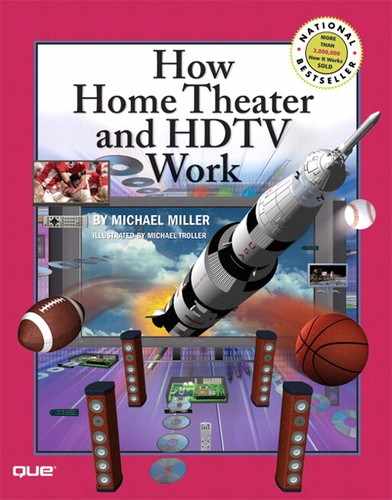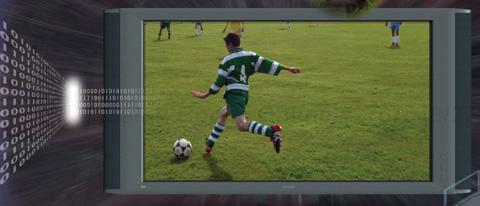Our current NTSC television system is more than a half-century old.What was state-of-the-art in the 1950s is woefully inadequate today; today’s larger television screens and higher-resolution source material require a better way to reproduce picture and sound than what we’ve grown used to over the years.
The first step to improving the quality of our television broadcasts is to move from analog to digital transmission. Just as digital compact discs replaced analog records, digital television will replace our outdated analog broadcasting system. Digital signals don’t deteriorate as analog signals do; a digital broadcast looks every bit as good in your home as it doesinthe broadcast studio.
Simply digitizing a picture, however, does not improve upon a mediocre source format. To dramatically improve the picture, the format itself has to be improved. This leads us to the next step in the evolutionary process—high-definition television (HDTV). HDTV uses digital technology to increase the picture’s resolution, resulting in a noticeably sharper and more life-like picture. Digital technology is also used to improve the sound quality, in the formofDolby Digital surround sound.
In addition, the HDTV format changes the aspect ratio of the picture to more closely resemble the wide screens used in your local cinema and to better match the human field of vision, which is twice as wide as it is high. The traditional television screen has a 4:3 aspect ratio—that is, if the picture is 4 units wide, it’s also 3 units tall. The HDTV format embraces a widescreen approach with a 16:9 aspect ratio—for every 16 units of width, you have just 9 units of height. The resulting picture is wider than a standard television picture and abetter fit for displaying widescreen movies and other programming.
But it’s not enough to say that a picture is high definition; there are actually several different HDTV formats available. For example, for broadcast television, you can find programming offered at both 720p and 1080i resolution, and some videogames offer 1080p resolution.The future high-definition DVD formats will also offer 1080p resolution. What’s the difference?
It’s all a matter of resolution, meaning how many lines are in the picture.The 720p format offers 720 lines of resolution, scanned progressively. The 1080i format offers 1080 lines of resolution, interlaced, and the 1080p format offers 1080 lines of resolution, scanned progressively. Any of these formats is a big improvement over the 480 lines (interlaced) offered by standard definition television.
If 1080p—the best possible HDTV picture—is possible, why bother with the other formats at all? Well, if bandwidth was unlimited and free, 1080p would always be the preferred choice. But bandwidth costs money and is often limited. That’s why television broadcastersfavor the 720p and 1080i formats, which use much less bandwidth than the 1080p format. In fact,1080i is the defacto standard for HDTV broadcasts today, with only a few broad-casters (suchasESPN) favoring 720p. (That’s because programming with lots of motion, such as sporting events, benefits from progressive scanning, even if the overall resolution is a tad less.)
To view 1080p programming, you’ll have to wait until one of the new high-definitionDVD formats arrives. Both Blu-ray Disc and HD DVD have more than enough capacity to store 1080p programming, although it’s likely only one of these competing formats will survive the upcoming format wars. (And let’s not forget Sony’s PlayStation3 videogame system; it’s the first game console to offer 1080p output for some really great-looking games.)
One big question about HDTV is when you’ll be able to receive HDTV signals. The reality is that viewers in most major cities can now receive digital broadcast signals from local stations representing the ABC, CBS, NBC, and FOX television networks. Several cable and satellite channels also offer HDTV programming, and the offerings are steadily growing in number.
The Federal Communications Commission (FCC) mandated that all commercial TV stations begin some form of HDTV broadcasting by May 1, 2002, offering at least half of their programs in high definition within 12 months of that date. In fact, the government wants broadcast stations to completely shift to HDTV format by 2006. While that date probably won’t be met (the changeover has taken longer than originally expected), sometime soon digital broadcasts will replace analog broadcasts, and the analog broadcast spectrum will be returned to the government for some future use.
This is why most large-screen televisions sold today are capable of receiving HDTV broadcasts, either via a built-in or add-on HDTV tuner. When you buy an HDTV-capable set today, you’re ready for all the HDTV programming that will be offered in the coming years. And don’t worry—that new HDTV set is still compatible with all of today’s analog television programming. You can watch all the traditional television programming you want and then switch to HDTV mode for the new high-resolution broadcasts.
Better picture, bigger picture, and better sound—that’s what digital television and HDTV is all about. What’s not to like?

